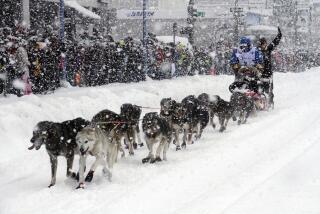A Little Tough Sledding Can’t Spoil Octogenarian’s Antarctic Dreams : Mission: Norman Vaughan has been handling dog teams for 65 years, and he’s training to take another expedition across the frigid land.
- Share via
ANCHORAGE, Alaska — Norman Vaughan has little time to reminisce about the glory days, 65 years ago, when he dropped out of Harvard, learned to mush dog teams and traveled Antarctica’s blank interior with Adm. Richard Byrd.
He’s busy at his one-room log cabin in Talkeetna, training dogs and working out in preparation for what will probably be the last sled dog expedition in Antarctica.
He also hopes to be the first to scale a 10,302-foot Antarctic mountain and to do it in time for his 88th birthday on Dec. 19.
This isn’t just any mountain. It’s Mt. Vaughan, a peak 250 miles from the South Pole that bears his name, thanks to Byrd.
“We will go,” said Vaughan, who plans a departure Monday for his five-person team. “You have to have something to shoot for.”
That’s not an empty sentiment. This white-haired, broad-smiling octogenarian has completed the 1,100-mile Iditarod Trail Sled Dog Race across Alaska six times, most recently in 1990.
And, in shooting for Antarctica, Vaughan says he has been exercising daily, sometimes with his dogs. Sometimes he goes to Anchorage, where he can climb into a swimming pool, wearing a life preserver and carrying heavy ski poles for an aerobic workout that mimics cross-country skiing.
“It sounds ridiculous, but really, I haven’t done anything that anyone else couldn’t do,” Vaughan said. “I’ve been persistent. And I don’t promote this necessarily, but I don’t drink and smoke.
“I’ve been trying to set an example. By doing that, all the rest falls into line.”
It’s not really that easy. It has taken two years to amass nearly $1.5 million to cover everything from 9,000 pounds of dog food to airlifts of supplies.
And Vaughan’s goal was threatened by an international treaty set to go into effect April 1 that seeks to protect indigenous wildlife by banning dogs on Antarctica. Scientists think canine distemper could spread to the continent’s seals.
But Vaughan, whose varied career has ranged from Air Force service to advertising to university janitor, was determined to close the era he helped begin by being the last musher to travel the continent.
With help from Sen. Ted Stevens (R-Alaska) and others, Vaughan finally won a permit Sept. 10 from the National Science Foundation.
“I think this will be more complicated than when Byrd did it. He had no restrictions on what he did,” said Vaughan, whose first trek relied on a hand-cranked radio, bulky caribou furs and a sextant.
Carolyn Vaughan, his fourth wife, has been in charge of staging the expedition. She says that once all the fuel, food, gear and radio equipment arrives at the starting point at Antarctica’s Camp DeGanahl, it will take a DC-6 airplane at least 10 more days to move supplies into position along their route.
Carolyn Vaughan, 50, also is part of her husband’s expedition, along with a physician and two climbers.
“Once I get on the plane, I’ll know it’s really happening,” she said. “I’ll heave a sigh of relief and think, ‘This is a great vacation.’ ”
Carolyn Vaughan, herself an Iditarod racer who has been working full time on the expedition for two years, says her husband has been her inspiration.
“His message is, never give up, and keep trying if it means something to you.”
More to Read
Sign up for Essential California
The most important California stories and recommendations in your inbox every morning.
You may occasionally receive promotional content from the Los Angeles Times.













